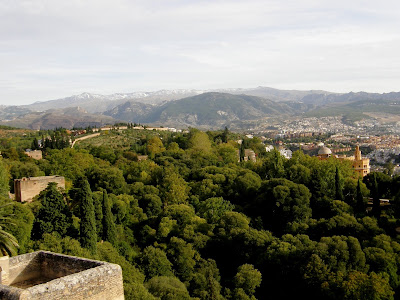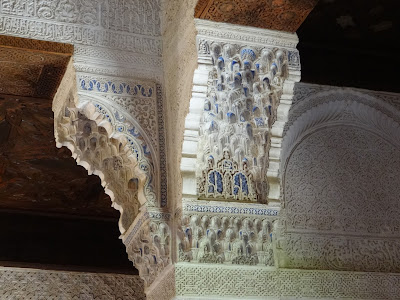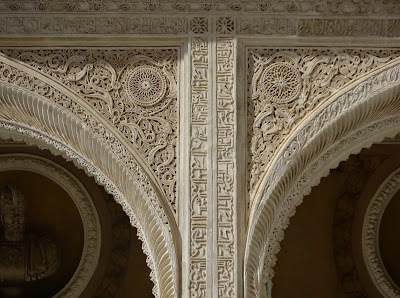One of the lovely fountains in the Lower Gardens which were replanted between 1931 and 1951 on the site of what were originally the palace orchards. It had become seriously neglected prior to its restoration. This fountain stands at the intersection of four rectangular pools which represent the Four Rivers of Paradise - water, milk, honey and wine.
As well as all the tranquil green of the trees there were also wonderful splashes of colour like this. I think that the building that is visible above the trees is the south pavilion of the Patio de la Acequia.
The Patio de la Acequia or Court of the Water Channel was originally designed as an enclosed interior garden following the Muslim tradition of an enclosed paradise but in later generations it was opened up with archways being let in to the west wall to give views over the surrounding countryside. The south and north ends were closed by pavilions - this is looking towards the south pavilion.
Originally the outside could only have been seen from the central Mirador of the Patio de la Acequia which stood in the centre of the west wall . A mirador is a balcony or small turret where one can look out over a garden or the countryside.
In this photo you can see the portico of the north pavilion and the archways that were made in the west wall.
The mirador in the north pavilion which looks out over the city of Granada. It was added in 1319 and it apparently always catches a little breeze to help alleviate the overpowering midday heat of summer.
The Cypress Courtyard which is also known as the Sultana's Courtyard because of the legend that the wife of the last of the Nasrid kings kept secret trysts with a knight of the Abencerrages family in a hollow in the trunk of the ancient cypress tree on the left of the photo. The Sultan was not amused when he discovered what was going on and as a result all the men of the Abencerrages family were put to death. We aren't told what the fate of the Sultana was! This may be just a story but the cypress tree is genuinely about 700 years old and is supported by the iron band that you can see round the trunk.
I can't quite remember where this charming little grotto is but I think it's a part of the Cypress Courtyard. I must say that I love the whole ethos of Muslim gardens - they are to be enjoyed with all the senses, the sight and scent of the flowers, the sound of water and the feel and taste of fruit as you pick and eat it from the trees as you walk beneath them. It's certainly my idea of Paradise!
After the gardens we went to explore the Alcazaba or Old Citadel. This was a fortress,the oldest part of the Alhambra. It was built in the mid 13th century by Sultan Alhamar founder of the Nasrid dynasty,and it certainly looks formidable. It was known in Arabic as qu'alat al-hamra which translates as the red castle. The Plaza de las Armas is where the soldiers were garrisoned along with blacksmiths, armourers etc. All that remains now are the foundations of the buildings but it's an impressive sight even so.
The centre of the five niches that you can see in the wall of the Plaza contains a pile of stone cannon balls.
The Alcazaba had its own bath complex with hot, cold and warm rooms and underfloor heating - baths were an essential part of Moorish culture. These are in ruins now but you can still see how it is divided up into the different areas.
The Alcazaba has several towers and if it was possible to climb them I did. This is the top of the Torre de la Vela or Watchtower, it's nearly 90 feet high and has a winding stone staircase. I don't know how many steps there are but it's an awful lot! I finally tottered out onto the top and leaned against a wall ostensibly admiring the view until I'd recovered a bit:) The original bell was brought to Granada and placed on the tower by the Catholic monarchs who finally took the city in January 1492. The current bell is still rung on January 2nd each year to commemorate this event.
There were wonderful views from many parts of the Alcazaba, here we are looking out over the city of Granada with its magnificent background of the Sierra Nevada which still has snow on some of its peaks.
We left the Alcazaba via the Parapet Gardens which were made at the beginning of the 17th century when the gap between the inner and outer ramparts was filled in with rubble and earth. It makes a very pleasant shady walk now.
One of the fountains that are tucked into corners as you walk down. I wonder whether the niche was to hold a lantern to light the pathway in the dark? By now it was nearly 5pm and we were more than ready to go back to our hotel for a shower before getting ready for dinner. I would love to go back to Granada, it was my favourite of the three cities that we visited. Just one more post to come now on our final day in Madrid then I can get back to writing normal posts:)
























































